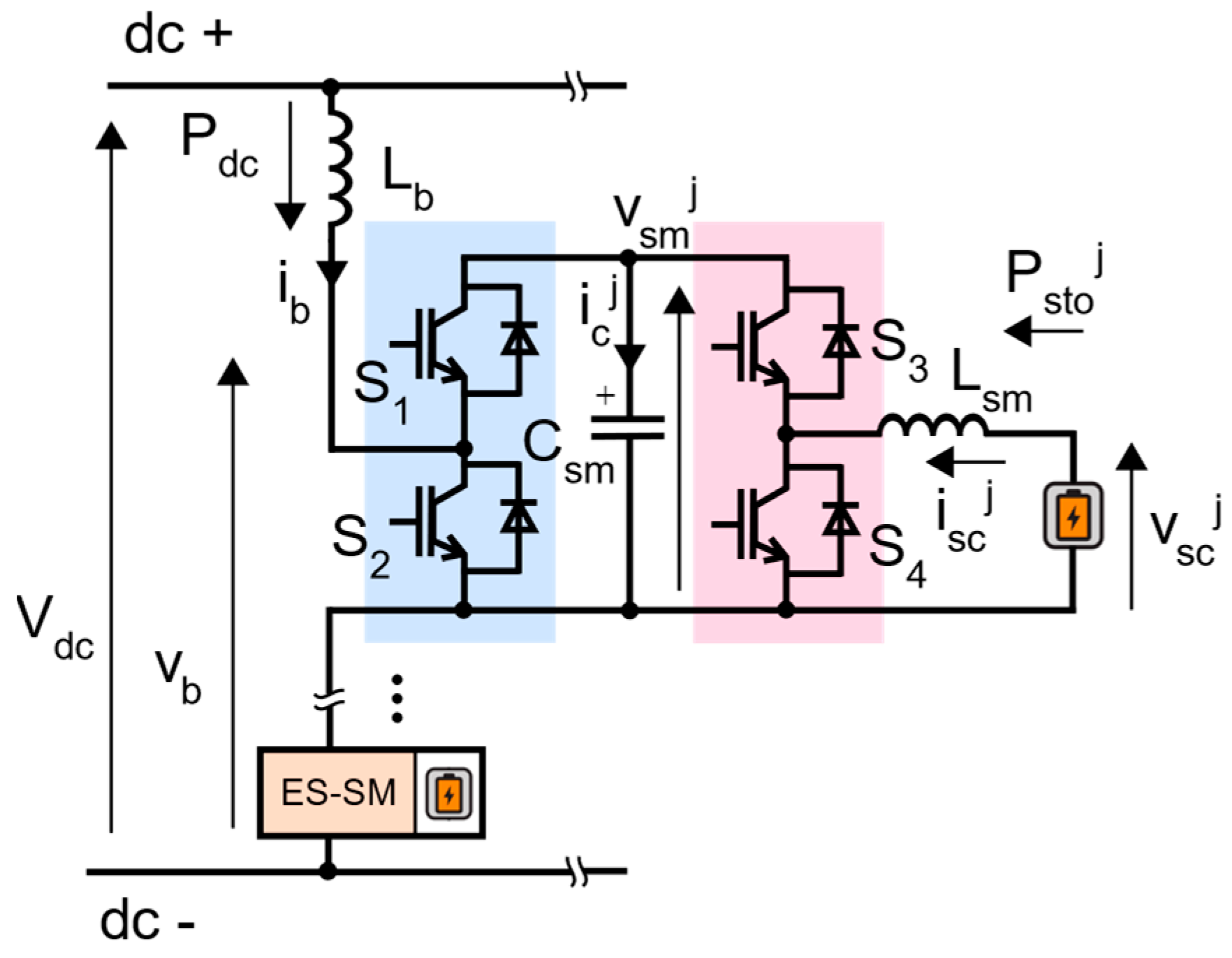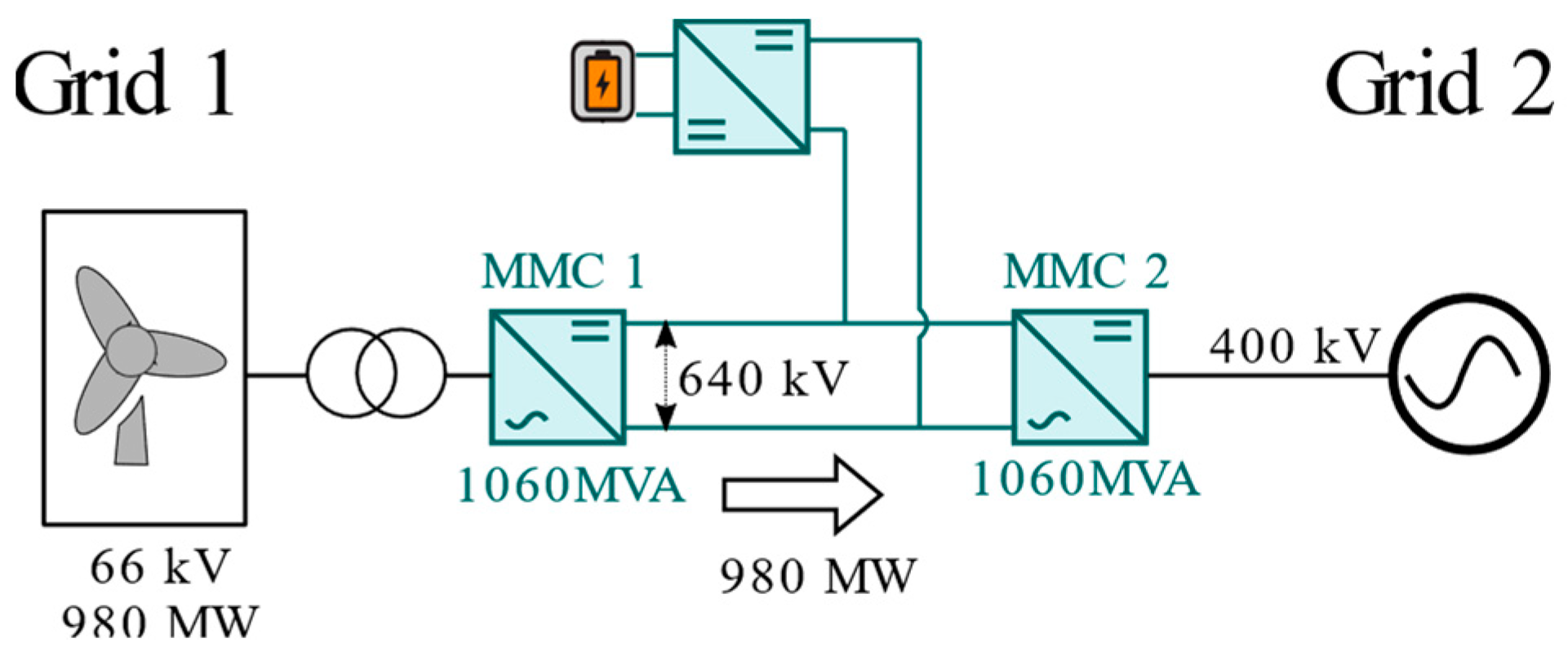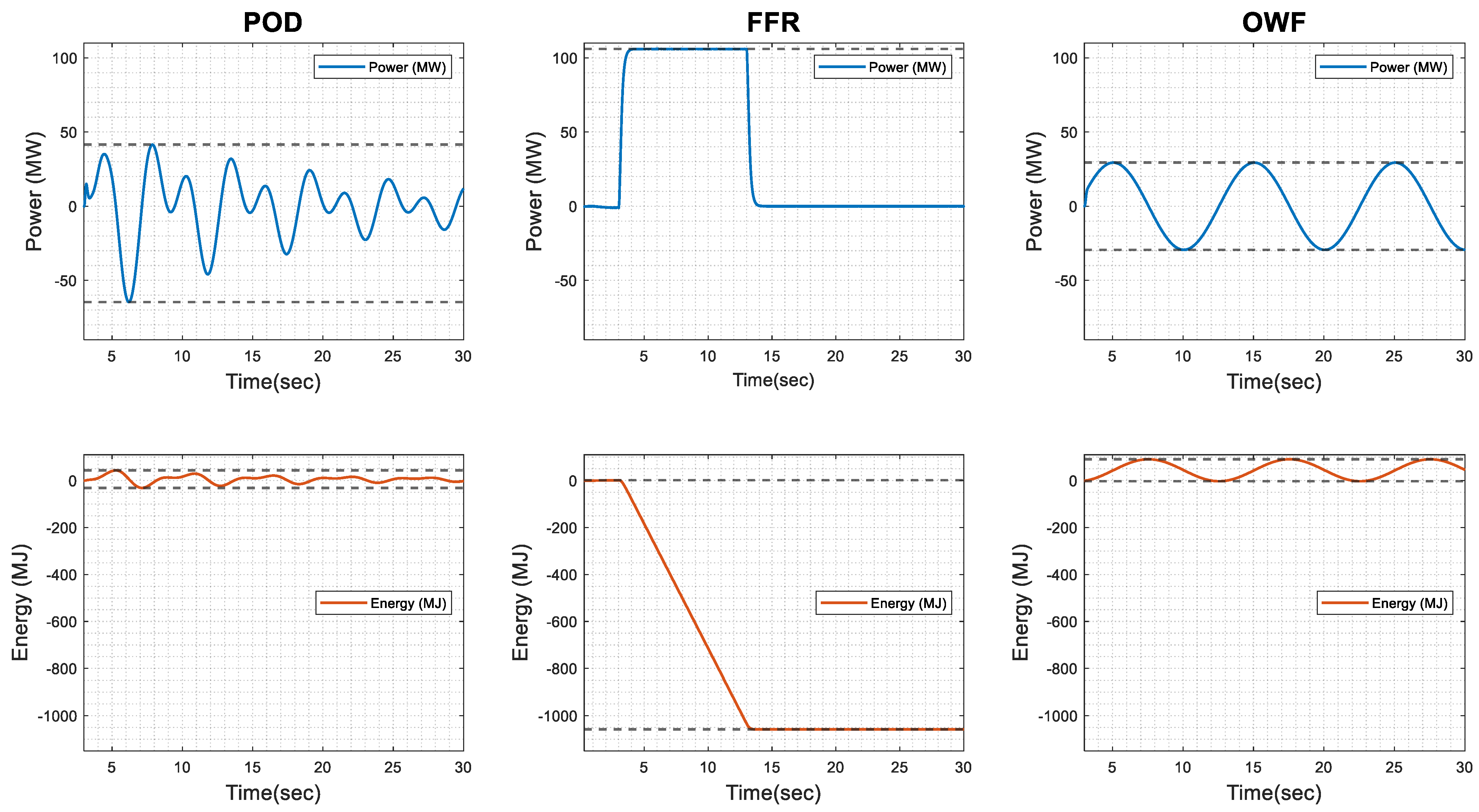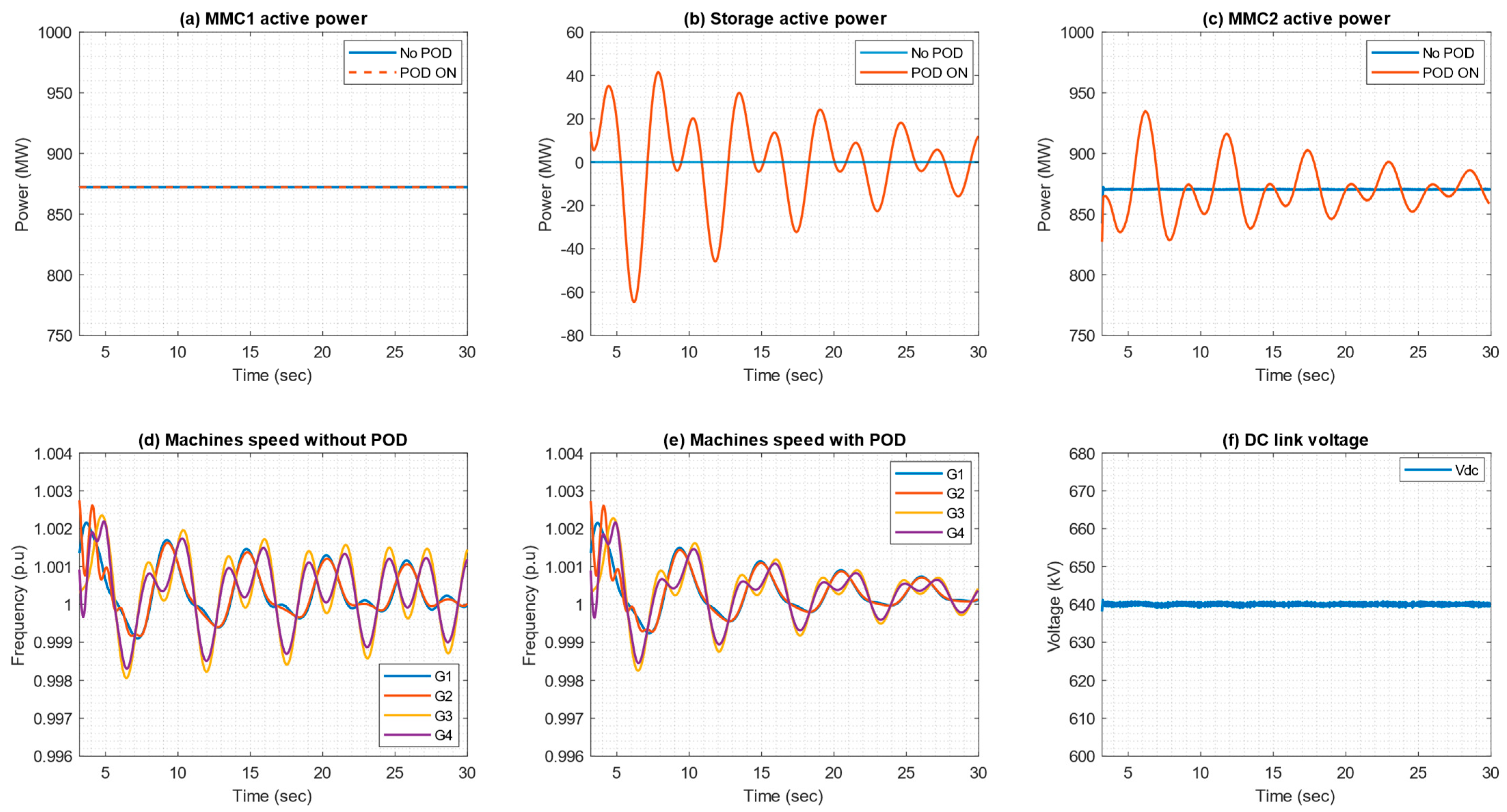Design of a Single Branch of Energy Storage Submodules Connected to HVDC Systems to Support AC Grids
Abstract
:1. Introduction
- A comprehensive approach is proposed to size an energy storage device and the corresponding converter connected to HVDC terminals for a specific service.
- This approach is used for three examples of AC services to obtain the characteristics of the main components of the converter, including the energy storage elements.
- The feasibility of the obtained energy storage converters is discussed for the three considered examples.
2. Proposed Converter to Integrate Energy Storage in an HVDC System and Methodology to Assess Its Technical Feasibility
2.1. Topology
2.2. Modelling
2.2.1. Model A
2.2.2. Model B
2.3. Control
2.4. General Methodology
2.5. Design of the Solution
2.5.1. Single-Branch Energy Storage Submodules
- Number of energy storage submodules
- Branch inductor
- Energy storage submodule capacitance
- Switch choice
2.5.2. Energy Storage Interface Converter
2.6. Design of the Energy Storage of an Energy Storage Submodule
- The influence of the thermal behaviour of the solution and switching harmonics on lifetime and system performance are neglected.
- Ageing is not considered, meaning that the design of the storage is made for the beginning of life (BoL).
- Load profile can be achieved upwards or downwards. This means that more energy is stored within the energy storage system to ensure both power directions.
- The maximum continuous current for a given temperature rise provided by the manufacturer datasheet is considered as the current limit (285 A for a rise of 40 °C for non-repetitive services with a short duration, 172 A for a rise of 15 °C for services that should be provided for a long duration [26]).
- Sizing at constant power is achieved. This means that the sizing cycles of the load profiles are simplified as an equivalent constant power load.
2.7. Key Indicators
3. Case Studies
3.1. Inter-Area Power Oscillation Damping
3.2. Fast Frequency Response between Two Asynchronous Networks
3.3. Offshore Wind Power Smoothing
3.4. System Requirements for Each Use Case
4. Results
4.1. System Design Results
4.2. Simulation Results
4.2.1. Inter-Area Power Oscillation Damping
4.2.2. Fast Frequency Response
4.2.3. OWF Power Smoothing
5. Conclusions
Author Contributions
Funding
Data Availability Statement
Conflicts of Interest
Nomenclature
| The dc component of a variable | |
| Equivalent ES-SM capacitance | |
| Capacitance of a supercapacitor module | |
| ES-SM capacitance | |
| Capacitance of the supercapacitor bank of an ES-SM | |
| Equivalent capacitance of the equivalent supercapacitor bank | |
| Ratio between the voltage and the nominal voltage of a supercapacitor bank | |
| Average duty cycle of the equivalent dc-dc converter | |
| Equivalent series resistance of a supercapacitor bank | |
| Equivalent series resistance of a supercapacitor module | |
| Equivalent ES-SM capacitor current | |
| Dc current flowing through a single branch | |
| Energy storage current of an ES-SM that flows toward an ES-SM capacitor | |
| Index for an ES-SM in the chain link | |
| Branch inductor | |
| Equivalent ES-SM filtering inductor | |
| Averaged modulation index | |
| Number of ES-SMs in a single branch | |
| Number of modules in series in a supercapacitor bank of an ES-SM | |
| Number of branches in parallel in a supercapacitor bank of an ES-SM | |
| Total number of modules in a supercapacitor bank of an ES-SM | |
| Dc power provided by the storage device | |
| Power provided by the storage device | |
| Branch resistance | |
| Equivalent ESR of the equivalent supercapacitor | |
| Equivalent ES-SM resistance | |
| Equivalent inserted voltage of the stack of ES-SMs | |
| Equivalent ES-SM capacitor voltage | |
| DC link voltage | |
| Nominal voltage of a supercapacitor module | |
| Voltage of a supercapacitor bank | |
| ES-SM capacitor voltage | |
| Energy stored within a supercapacitor bank |
References
- Alhomsi, H.; Linke, F.; Westermann, D. AC System Restoration Using Embedded MT-HVDC. In Proceedings of the IEEE PES ISGT Europe, Novi Sad, Serbia, 10–12 October 2022. [Google Scholar]
- Spallarossa, C.; Merlin, M.; Green, T. Augmented inertial response of Multi-Level Converters using internal energy storage. In Proceedings of the IEEE ENERGYCON, Leuven, Belgium, 4–8 April 2016. [Google Scholar]
- Gonzalez-Torres, J.-C.; Mourouvin, R.; Shinoda, K.; Zama, A.; Benchaib, A. A simplified approach to model grid-forming controlled MMCs in power system stability studies. In Proceedings of the IEEE PES ISGT Europe, Espoo, Finland, 18–21 October 2021. [Google Scholar]
- Rokrok, E.; Qoria, T.; Bruyere, A.; François, B.; Haibo, Z.; Belhaouane, M.; Guillaud, X. Impact of grid-forming control on the internal energy of a modular multilevel converter. In Proceedings of the EPE ECCE Europe, Lyon, France, 7–10 September 2020. [Google Scholar]
- Groß, D.; Sánchez-Sánchez, E.; Prieto-Araujo, E.; Gomis-Bellmunt, O. Dual-Port Grid-Forming Control of MMCs and Its Applications to Grids of Grids. IEEE Trans. Power Deliv. 2022, 37, 4721–4735. [Google Scholar] [CrossRef]
- CIGRE Working Group B4.84. Feasibility Study and Application of Electric Energy Storage Systems Embedded in HVDC and STATCOM Systems; CIGRE Technical Brochure 935: Paris, France, 2024. [Google Scholar]
- Farivar, G.; Manalastas, W.; Tafti, H.; Ceballos, S.; Sanchez-Ruiz, A.; Lovell, E.C.; Konstantinou, G.; Townsend, C.; Srinivasan, M.; Pou, J. Grid-Connected Energy Storage Systems: State-of-the-Art and Emerging Technologies. Proc. IEEE 2023, 111, 397–420. [Google Scholar] [CrossRef]
- Frey, K.; Garg, M.; Morgenstern, R.; Platt, N.; Spahic, E. Provision of fast frequency response by SVC plus frequency stabilizer. In Proceedings of the IET ACDC, Coventry, UK, 5–7 February 2019. [Google Scholar]
- Meng, L.; Heydari, R.; Bai, H.; Hasler, J.-P.; Ingeström, G.; Kheir, J.; Owens, A.; Svensson, J. Energy Storage Enhanced STATCOM for Secure and Stable Power Grids. In Proceedings of the CIGRE Session, Paris, France, 28 August–2 September 2022. [Google Scholar]
- Postiglione, G.; Anderotti, M.; Borghetti, G.; Finotti, C.; Pacchioni, M.; Ripamonti, M.; Lacerda, V.A.; Bellmunt, O.G.; Araujo, E.P.; Labady, A. An improved modular STATCOM topology equipped with short-time energy storage and grid forming control for HV network voltage and frequency regulation. In Proceedings of the CIGRE Session, Paris, France, 25–30 August 2024. [Google Scholar]
- Avdiaj, E.; Lindner, M.; Schöll, C.; Beerten, J. Design of an MMC-based grid-forming STATCOM with DC supercapacitors for energy storage. In Proceedings of the CIGRE Colloquium, Vienna, Austria, 12–14 September 2023. [Google Scholar]
- Errigo, F.; de Oliveira Porto, L.; Morel, F. Design Methodology Based on Prebuilt Components for Modular Multilevel Converters with Partial Integration of Energy Storage Systems. Energies 2022, 15, 5006. [Google Scholar] [CrossRef]
- Judge, P.; Green, T. Modular Multilevel Converter with Partially Rated Integrated Energy Storage Suitable For Frequency Support and Ancillary Service Provision. IEEE Trans. Power Deliv. 2019, 34, 208–219. [Google Scholar] [CrossRef]
- Blatsi, Z.; Judge, P.; Finney, S.; Merlin, M. Blackstart Capability of Modular Multilevel Converters From Partially-Rated Integrated Energy Storage. IEEE Trans. Power Deliv. 2023, 38, 268–276. [Google Scholar] [CrossRef]
- Tayyebi, A.; Dijkhuizen, F.; Larsson, M.; Johansson, N.; Berggren, B.; Alves, R.; Gohil, G.; Kannan, V.; Hafner, Y.-J. On the role of energy storage and grid-forming control in the future HVDC systems. In Proceedings of the CIGRE Session, Paris, France, 25–30 August 2024. [Google Scholar]
- Errigo, F.; Morel, F.; De Vienne, C.M.; Chédot, L.; Sari, A.; Venet, P. A Submodule with Integrated Supercapacitors for HVDC-MMC providing Fast Frequency Response. IEEE Trans. Power Deliv. 2022, 37, 1423–1432. [Google Scholar] [CrossRef]
- Pinheiro, D.L.M.; Errigo, F.; Morel, F. A DC/DC converter for centralized energy storage in HVDC applications. In Proceedings of the IET PEMD, Nottingham, UK, 10–13 June 2024. [Google Scholar]
- HVDC-WISE Project. Deliverable 4.1: Identification of Key Technologies, Potential Benefits and Restrictions. 2023. Available online: https://hvdc-wise.eu/resources/ (accessed on 5 August 2024).
- Bharadwaj, C.A.; Maiti, S. Modular multilevel E-STATCOM considering distributed energy storage at the dc link. In Proceedings of the IEEE PIICON, Bikaner, India, 25–27 November 2016. [Google Scholar]
- Montesinos-Miracle, D.; Massot-Campos, M.; Bergas-Jane, J.; Galceran-Arellano, S.; Rufer, A. Design and Control of a Modular Multilevel DC/DC Converter for Regenerative Applications. IEEE Trans. Power Electron. 2013, 28, 3970–3979. [Google Scholar] [CrossRef]
- Mahr, F.; Jaeger, J.; Henninger, S.; Rubenbauer, H. Hybrid Energy Storage System for MVDC-Grids. In Proceedings of the EPE ECCE Europe, Lyon, France, 7–11 September 2020. [Google Scholar]
- Sau-Bassols, J.; Morel, F.; Errigo, F.; Bekkouri, H.; Gonzalez, J.C.; Benchaib, A. Single branch of energy storage submodules to integrate energy storage devices in HVDC systems. In Proceedings of the 19th International Conference on AC and DC Power Transmission (ACDC 2023), Glasgow, UK, 1–3 March 2023. [Google Scholar]
- Errigo, F.; Gonzalez-Torres, J.-C.; Benchaib, A.; Chédot, L.; Sari, A.; Venet, P.; Morel, F. Modular Multilevel Converter with Embedded Energy Storage for Power Oscillation Damping and Fast Frequency Response—A case study. In Proceedings of the CIGRE Symposium, Ljubljana, Slovenia, 21–24 November 2021. [Google Scholar]
- Saad, H.; Dennetière, S.; Mahseredjian, J.; Delarue, P.; Guillaud, X.; Peralta, J.; Nguefeu, S. Modular Multilevel Converter Models for Electromagnetic Transients. IEEE Trans. Power Deliv. 2014, 29, 1481–1489. [Google Scholar] [CrossRef]
- Alvarez, R.; Pieschel, M.; Gambach, H.; Spahic, E. Modular multilevel converter with short-time power intensive electrical energy storage capability. In Proceedings of the 2015 IEEE Electrical Power and Energy Conference (EPEC), London, ON, Canada, 26–28 October 2015. [Google Scholar]
- Skeleton Products-Supercapacitor Modules. [Online]. Available online: https://www.skeletontech.com/en/supercapacitor-modules (accessed on 22 August 2024).
- Barrade, P.; Rufer, A. Current capability and power density of supercapacitors: Considerations on energy efficiency. In Proceedings of the European Conference on Power Electronics and Applications (EPE), Toulouse, France, 2–4 September 2003. [Google Scholar]
- Campos, A.; Jasi, A.; Vershinin, K.; Dworakowski, P. CO2 Footprint of Medium Voltage DC Solid State Transformer. In Proceedings of the PCIM Europe, Nuremberg, Germany, 11–13 June 2024. [Google Scholar]

















| Grid Services | Peak Power [MW] | Average Power [MW] | Maximum Energy Variations [MJ] |
|---|---|---|---|
| POD | 64.6 | 40.3 | 74.6 |
| FFR | 106 | 100 | 1059 |
| Smoothing | 29.4 | 18.7 | 93.6 |
| Quantities | Case 1—POD | Case 2—FFR | Case 3—OWF |
|---|---|---|---|
| System requirements | |||
| Peak power (MW) | 74.6 | 106 | 29 |
| Total energy to store (MJ) | 149.2 | 2116 | 187 |
| Number of energy storage submodules | 190 | ||
| HB energy storage submodule | |||
| Switch maximal voltage (kV) | 6.5 | ||
| Switch operating voltage (kV) | 3.8 | ||
| Continuous dc current of the IGBT (A) | 250 | ||
| Peak current through the switches (A) | 101 | 166 | 46 |
| (mF) | 0.52 | 0.68 | 0.24 |
| Energy storage submodule interface converter | |||
| Switch voltage capability (kV) | 6.5 | ||
| Switch operating voltage (kV) | 3.8 | ||
| Continuous dc current of the IGBT (A) | 600 | 750 | 250 |
| Peak current through the switches (A) | 398 | 660 | 200 |
| (kHz) | 1 | ||
| (mH) | 17 | 11 | 31 |
| Energy storage elements for one ESM | |||
| 10 | 17 | 9 | |
| 1 | 2 | 1 | |
| Nominal supercapacitor bank voltage (V) | 1020 | 1734 | 918 |
| Maximum dc current considered (A) | 285 | 285 | 172 |
| Volume (L) | 296 | 1006 | 266 |
| Weight (kg) | 265 | 901 | 239 |
| Performance indicators | |||
| Utilization factor, UF | 0.17 | 0.72 | 0.24 |
| Total number of modules | 1 900 | 6 460 | 1 710 |
| Total volume of energy storage element (L) | 56 240 | 191 216 | 50 616 |
Disclaimer/Publisher’s Note: The statements, opinions and data contained in all publications are solely those of the individual author(s) and contributor(s) and not of MDPI and/or the editor(s). MDPI and/or the editor(s) disclaim responsibility for any injury to people or property resulting from any ideas, methods, instructions or products referred to in the content. |
© 2024 by the authors. Licensee MDPI, Basel, Switzerland. This article is an open access article distributed under the terms and conditions of the Creative Commons Attribution (CC BY) license (https://creativecommons.org/licenses/by/4.0/).
Share and Cite
Errigo, F.; Sau-Bassols, J.; Bekkouri, H.; Morel, F.; Gonzalez-Torres, J.-C.; Benchaib, A.; Rault, P.; Bourgeat, X. Design of a Single Branch of Energy Storage Submodules Connected to HVDC Systems to Support AC Grids. Electronics 2024, 13, 3355. https://doi.org/10.3390/electronics13173355
Errigo F, Sau-Bassols J, Bekkouri H, Morel F, Gonzalez-Torres J-C, Benchaib A, Rault P, Bourgeat X. Design of a Single Branch of Energy Storage Submodules Connected to HVDC Systems to Support AC Grids. Electronics. 2024; 13(17):3355. https://doi.org/10.3390/electronics13173355
Chicago/Turabian StyleErrigo, Florian, Joan Sau-Bassols, Hind Bekkouri, Florent Morel, Juan-Carlos Gonzalez-Torres, Abdelkrim Benchaib, Pierre Rault, and Xavier Bourgeat. 2024. "Design of a Single Branch of Energy Storage Submodules Connected to HVDC Systems to Support AC Grids" Electronics 13, no. 17: 3355. https://doi.org/10.3390/electronics13173355






